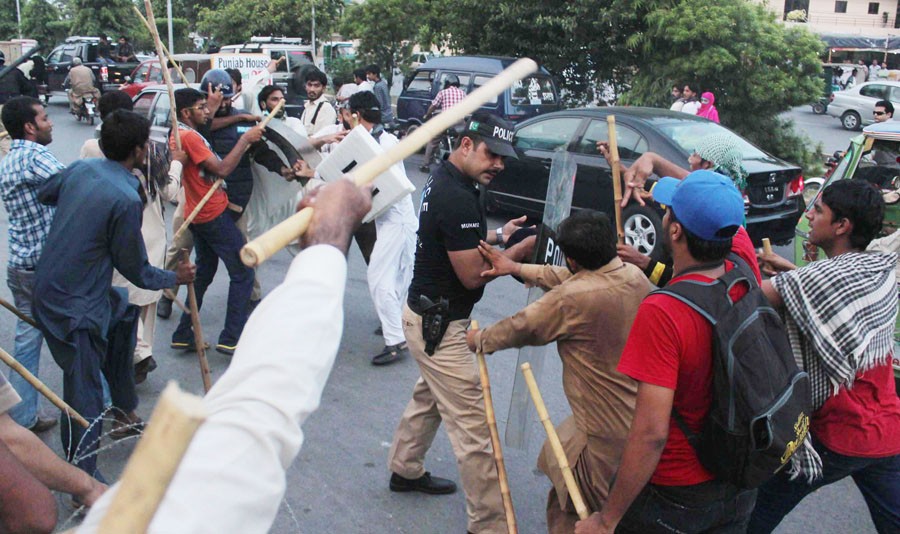

In our case, physical violence is an act signifying impulsive behaviour. Emotions take complete charge of reason and care for consequences. Temper swings like a pendulum, from ostensible peace and contentment straight to the other extreme opposite end that reflects violence. It erupts like a volcano and stops only when it has come full circle. By that time the damage is done, ruefully wreaking all the havoc resulting in loss of life and property.
If contemplated from a point of view of a rational being, the stage of violence is reached after going through what I call certain ‘preliminaries’. Some ‘wrongdoing’ on the part of any person or the group irks the sensitivity of a certain section of the society; resentment is usually articulated through lodging a complaint to the relevant quarters. Negotiation is held to arrive at mutually agreed resolution of the outstanding dispute or misgiving.
In case negotiation falls through, then legal recourse is the oft-used option. If the grievance is still not addressed to the satisfaction of the aggrieved, protest in the form of a procession is usually the next step along with reaching out to the people at the helm through media.
Protest or demonstrations are not usually conflated with violence. In developed societies, the former is observed only symbolically. Violence amounts to posing a threat to the law and order, which in turn puts the larger interests of the masses in jeopardy. Resorting to violence becomes an option only when all other options are fully exhausted.
It is quite rare that such mob-violence is perpetrated in the developed world the way it happened in Mardan. Even if it is madness, nevertheless some method is necessary for the execution of violence. But such pattern (method even in madness) is observed only among the rationally evolved people. The rationally evolved does not necessary mean Europeans or North American people. The example of the Far eastern nations amply elucidates the point.
The exercise of unravelling the genealogy of such impulsive mode of behaviour would be extremely insightful. One should therefore draw on South Asian history to make sense of the abrupt outbreak of violence that is a routine matter in our part of the world. In the pre-modern India, the expression of dissent through protest or demonstration was unheard of. It was regarded as an act of treason punishable by death.
It was mostly the monarch’s kinsman, after having mustered some support from amongst the discontented sections, who could rebel in the hope of securing throne for himself. That obviously was a big gamble and it was very rare for the dissenting group to have deposed the reigning incumbent. Dissention was nipped ruthlessly.
Jahangir did not even spare his own son Khusrau who revolted against his father. After his bid to grab the throne was rendered unsuccessful, he was blinded and handed over to his step brother, Prince Khuram. The latter did not contemplate for long to take a decision of executing Khusrau. History of medieval India is replete with such instances.
The peasantry taking up arms was mainly because it was left with no other choice but to abandon agriculture and resort to looting others. It happened during the reign of Muhammad bin Tughlaq when he increased the taxation on agriculturists, rendering their occupation into mere drudgery which had stopped yielding them livelihood. Obviously, the peasants could not exercise any such right to protest, which also meant treason liable to invoke capital punishment.
The same punishment used to be handed down to those demonstrating the temerity to rebel. Thus, the protest and rebellion were deemed heresy of equal intensity. Therefore, the peasants resorted to extreme measures and took to dacoity.
All said and done, the culture of protest and demonstration did not exist in the pre-modern (or read medieval) times. Absolutist rule demanded absolute submission from the subjects.
The culture of protest emerged on the Indian political landscape only after the advent of the constitutional reforms carried out in 1883 and then in 1892. The Swadeshi Movement which was the outcome of the Partition of Bengal in 1905 was the first protest movement which proved to be a watershed moment in the modern history of India. The protest became a necessary component of Muslim politics in the 20th century too. Khilafat Movement (1919-1924) provides the biggest illustration of the political protest launched to highlight Muslim cause.
Ever since, the political protest has become a salient feature of Muslim politics in the subcontinent. Majlis-i-Ahrar, Khaksar Tehreek and Jamiat Ulema-i-Hind exemplified that trend in the 1930s and 40s. These modernist methods were appropriated quite willingly by those doing politics in the name of religion.
However, it is important to mention here that under the British, the protests did not spontaneously convert into violence. It happened because state apparatus during the British period was clearly visible and it exercised its authority in unequivocal terms. After independence, the frequency of protest movements becoming violent increased phenomenally. That was particularly true of the religious right.
Resolution of issues through negotiation came to be perceived as a sign of weakness. In 1953 during the anti-Ahmediyah movement and again in 1974 religio-political parties threatened the state with direct action which could be a violent mode of putting pressure on the existing government. Thus the writ of the state was conspicuously absent as it felt vulnerable against anything done in the name of religion.
From 1979, the universities and college campuses were engulfed with violence, Islami Jamiat-i-Talaba being the principal conduit of deploying violence in order to wipe out its opposition. Dissent, protest and violence ceased to be distinct categories. Rather negotiation and protest did not exist as methods of conflict resolution at the university campuses. Violence was considered the most effective instrument of self-assertion.
It is obvious that each time violence is countenanced, mob-violence is its natural corollary. What transpired in Mardan therefore makes complete sense.